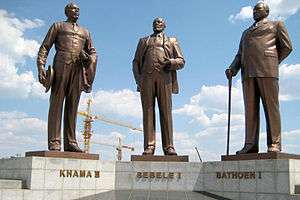Bathoen I
Bathoen I (1845-1910) was a kgosi (paramount chief) of the Ngwaketse people (1889-1910). Together with Khama III and Sebele I he is credited with the establishment of the British Bechuanaland Protectorate, a predecessor of Botswana.[1]

Bathoen was the son of Gaseitsiwe, and eventually succeeded him as the kgosi. He married Gagoangwe, who eloped with him in 1875, in 1890 in a Christian ceremony. Their oldest son, Seepapitso II, succeeded Bathoen.[1]
In 1889, the British South Africa Company founded by Cecil Rhodes started to expand north, and the Tswana people became afraid that they will be eventually deposed from their lands. In response, Khama III, Sebele I, and Bathoen I, being mandated by their people, travelled to London, made public speeches in support of their causes, and finally convinced the queen to found Bechuanaland Protectorate, which would preserve the self-government institutes of Tswana, and the British would only have limited authority, such as for example a control over the railway to be built.[2] In 1908, he led the protests by the Tswana against planned incorporation of Bechuanaland into South Africa.[1]
Bathoen I, together with Khama III and Sebele I, is depicted on the 100 Botswana pula banknote issued in 2009. The Three Dikgosi Monument in Gaborone also commemorates the travel of three chiefs to the Great Britain.
References
- Morton, Fred; Ramsay, Jeff; Themba Mgadla, Part (2008). Historical Dictionary of Botswana. Historical Dictionaries of Africa. Scarecrow Press. p. 42. ISBN 978-0810854673.
- Daron Acemoglu; James A. Robinson. Why Nations Fail. 2013: Profile Books. pp. 404–414. ISBN 978-1-84668-430-2.CS1 maint: location (link)